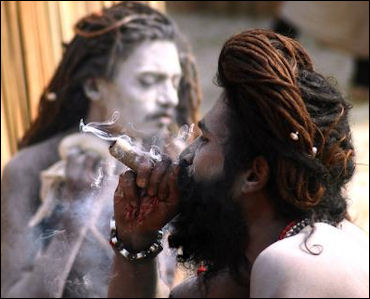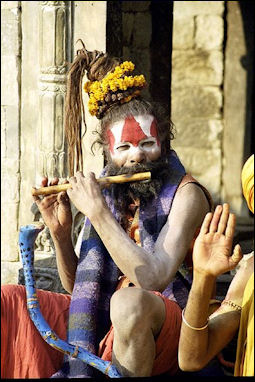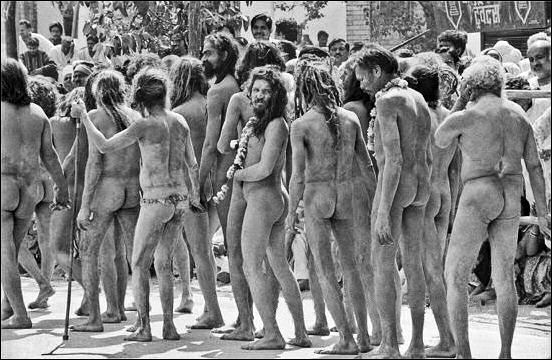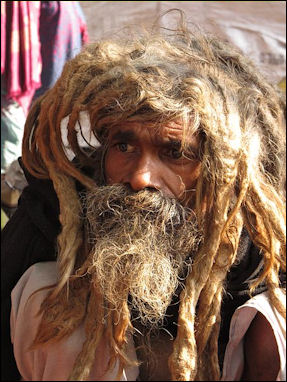SADHUS

Sacred charas “Sadhus” are wandering ascetics affiliated with a wide range of Hindu religious orders and schools. Found throughout India and Nepal, they are seen in towns and cities and walking along roads with begging pots and staffs. They are respected by Hindus and given food in return for their blessings and prayers. A fakir is a holy man who lives by begging. Other terms applied to sadhus include Baba, Yati, Yogi, Jogi, Swami, Muni, Sant, Sanyasi, Mahatma, Tapasi and Tapsawi
The term sadhu is used to refer to any of the millions of mendicant ascetics who are informally associated with the various Hindu religious orders in India. While most of these wandering holy persons are male, there are also women (known as sadhvin, the feminine form of sadhu) among their ranks. Originally only Brahmins were allowed to become sadhus. Now members of any caste can become one. They take vows of chastity and poverty, adopt ascetic practices, observe certain religious regulations, survive on charities, and provide religious services to those in need. They are expected to severe ties with family or home and wear markings and clothes associated with the sect they belong too. [Source: Hugh R. Page, Jr.,“Encyclopedia of World Cultures Volume 3: South Asia,” edited by Paul Hockings, 1992 |~|]
Sadhus are expected to adopt ascetic practices, observe religious regulations, and provide teaching or service to those in need. Their ascetic practices include departing from family and home, applying bodily markings often associated with a particular sect, wearing attire associated with a particular sect (or being partially or totally naked), growing hair only on five important bodily parts (the head, upper jaw, chin, armpits, and pubic region) or completely shaving the body, adopting a mendicant or sedentary lifestyle, and depending on the goodness of others for daily survival. Sadhus are revered by Hindus as representatives of the gods. Being a sadhu is one of the stages of life a person is expected to pass through. Even so in the caste system sadhus often occupy a position roughly equal to that of domestic servants. |~|
Websites and Resources on Hinduism: Hinduism Today hinduismtoday.com ; India Divine indiadivine.org ; Wikipedia article Wikipedia ; Oxford center of Hindu Studies ochs.org.uk ; Hindu Website hinduwebsite.com/hinduindex ; Hindu Gallery hindugallery.com ; Encyclopædia Britannica Online article britannica.com ; International Encyclopedia of Philosophy iep.utm.edu/hindu ; The Hindu Religion, Swami Vivekananda (1894), .wikisource.org ; Journal of Hindu Studies, Oxford University Press academic.oup.com/jhs
RECOMMENDED BOOKS:
“Sadhus: Holy Men of India” by Dolf Hartsuiker Amazon.com ;
“Sadhus: Going Beyond the Dreadlocks” by Patrick Levy Amazon.com ;
“Wisdom of the Sadhu: Teachings of Sundar Singh” by Sadhu Sundar Singh and Kim Comer Amazon.com ;
“The Hindu Temple and Its Sacred Landscape” (The Oxford Centre for Hindu Studies)
by Himanshu Prabha Ray Amazon.com ;
“Hindu Rites And Rituals: Origins And Meanings” by K V Singh Amazon.com ;
“Hindu Rites, Rituals, Customs & Traditions” by Prem P. Bhalla Amazon.com ;
“Durga Puja,Lakshmi Puja,Saraswati Puja,Navratri Puja : Hindu Home Puja Book: Complete Ritual Worship Procedure” by Santhi Sivakumar Amazon.com ;
“Shiva Beginner Puja” by Swami Satyananda Saraswati and Shree Maa Amazon.com ;
"An Introduction to Hinduism" by Gavin Flood Amazon.com ;
“Hinduism for Beginners - The Ultimate Guide to Hindu Gods, Hindu Beliefs, Hindu Rituals and Hindu Religion” by Cassie Coleman Amazon.com ;
"The Hindus: An Alternative History" by Wendy Doniger; Amazon.com ;
“Myths and Symbols in Indian Art and Civilization” by Heinrich Zimmer (Princeton University Press, 1992) Amazon.com
History of Sadhus and Hindu Aceticism

Sadhu have been around for at least 2000 years . They were called "the silent ones" or the "the long haired ones" in ancient Vedic verses. In ancient times sadhuism was regarded as the highest form of religious life and the power of sadhu penance was such, it was said, that the gods unsuccessfully set down cosmic beauties to try to seduce them and generals laid down their arms rather than wage war against a city protects by a “sadhus” .
There are three major Hindu religious orders: Vaishnava, Shaiva, and Shakta. Shaivism is believed by some to represent the original religious faith of India, already in place before the arrival of the Aryans. The orders have spawned numerous subdivisions, resulting in the current existence of numerous sects. Some of these sects are orthodox, while others are reformist or radical. [Source: Hugh R. Page, Jr.,“Encyclopedia of World Cultures Volume 3: South Asia,” edited by Paul Paul Hockings, 1992 |~|]
The roots of Hindu asceticism can be traced back to the fourfold division of life outlined in Vedic literature. These stages are: brahmacarin (the life of the pupil); grhastha (the life of the householder, which includes marriage, procreation, and the practice of a craft); vanaprastha (the life of the forest hermit, resorted to when the transitory nature of worldly pleasures is realized); and sannyasin (the life of the wandering beggar who has renounced all worldly ties). It is possible to claim asceticism without having experienced all stages of life. In modern times, some ascetics have chosen to remain married, which is a deviation from traditional practices. |~|
In his book “Mystics, Ascetics and Saints of India” (1903), “J. C. Oman wrote; " Sadhuism, whether perpetuating the peculiar idea of the efficacy of asceticism for the acquisition of far-reaching powers over natural phenomena, or bearing its testimony to the belief in the indispensableness of detachment from the world as a preparation for the ineffable joy of ecstatic communion with the Divine Being, has undoubtedly tended to keep before men's eyes, as the highest ideal, a life of purity, self-restraint, and contempt of the world and human affairs. It has also necessarily maintained amongst the laity a sense of the righteous claims of the poor upon the charity of the more affluent members of the community. Further, Sadhuism, by the multiplicity of the independent sects which have arisen in India has engendered and favoured a spirit of tolerance which cannot escape the notice of the most superficial observer."
Sadhu Customs and Duties

Juna Akhada initiation
Sadhu religious duties include acts of self-purification, worship, participation in religious discourses, studying sacred literature, and making pilgrimages. Sadhus are expected to provide services to the larger society, such as consoling those in distress, preaching and teaching religious tenets, granting assistance to the poor, and establishing schools and hospitals. [Source: Hugh R. Page, Jr.,“Encyclopedia of World Cultures Volume 3: South Asia,” edited by Paul Hockings, 1992]
Hindu and Jain sadhus live an ascetic life. They have chosen to wear ocher robes, or perhaps no clothing at all, to daub their skin with holy ash, to pray and meditate, and to wander from place to place, depending on the charity of others. Most have given up affiliation with their caste and kin and have undergone a funeral ceremony for themselves, followed by a ritual rebirth into their new ascetic life. They come from all walks of life, and range from illiterate villagers to well-educated professionals. In their new lives as renunciants, they are devoted to spiritual concerns, yet each is affiliated with an ascetic order or subsect demanding strict adherence to rules of dress, itinerancy, diet, worship, and ritual pollution. Within each order, hierarchical concerns are exhibited in the subservience novitiates display to revered gurus. Further, at pilgrimage sites, different orders take precedence in accordance with an accepted hierarchy. Thus, although sadhus have foresworn many of the trappings of ordinary life, they have not given up the hierarchy and interdependence so pervasive in Indian society. [Source: Library of Congress]
Hindus Sadhus and Buddhist monks have some similar customs. Both wander from place to place, surviving off alms and the goodness of others. In India it is a tradition for old men to leave their families and seek salvation. This is rooted in the Hindu belief in four stages of life: 1) studentship; 2) becoming a householder; 3) retiring to the forest to meditate; and 4) becoming a mendicant ("sannyasi"). During the third stage a man is expected to move into a hut in the forest with his wife and perform religious exercises. During the forth stage a man is expected to renounced all his worldly possession and become a beggar and devote himself totally to religion. According to the Laws of Manu:
He should not wish to die.
nor hope to live.
but await the time appointed
as a servant awaits his wages...
Rejoicing in the things of the spirit.
calm.
caring in for nothing.
abstaining from sexual pleasure.
himself his only helper.
he lives in the world.
In hope of eternal bliss”
Some sadhus wander and travel a great deal. Others are more sedentary. Their religion duties include acts of self purification, worship, participation in religious discourses, making pilgrimages and studying religious texts. They also preach, teach religious doctrine, help the poor and troubled, and open schools and hospitals.
A shaved head is a sign of penance. Many devotees have shaved heads this when they first become sadhus. The offering of water is considered a sign of respect. A water pot in some sects is the only possession a sadhu is allowed to own. It is the equivalent of the begging bowl of a Buddhist monk.
Many sadhus are Shaivaites. See Shaivites (Devotees of Shiva) Under HINDU SECTS AND SCHOOLS factsanddetails.com
Sadhu Clothes and Markings
Sadhus generally identify which sect they belong to by clothing color, symbols on specific parts of their body and possessions such as a rosary, water pot or staff. Sometimes body adornments are expressions of sadhus individuality and artisanship rather than symbols of a sect.

Some Hindu holy men wear saffron robes, holy beads and have a vermillion and ash spot on their forehead. Others wear only a loin cloth. Some wear only a loin cloth and a gold chain or a gold bracelet. Some wear nothing at all. Nagas are known for walking around completely naked.
Many sadhus follow rules in which they are allowed to grow hair in five areas: their head, their upper jaw, their chin, their armpits and their pubic areas. Some sadhus shave their entire bodies. Brahmin sadhus are identified by a sacred thread that runs diagonally from their left shoulder to their waist under their right arm.
During important festival sadhus cover their bodies with paint, sandalwood ash, and even sequins. On holy days some loin-cloth-clad sadhus wrap flowers around the top-knot in the their hair and smear their bodies with ashes. Sometimes their outfits can be quite elaborate. One mendicant was observed in a Mysore village with more than 100 different items on his body. It took him a couple of hours to dress and put on all his religious markers.
Some sadhus cover themselves with the ash of cremated bodies. Some tikkas are made from the ash of incense. Others place the mark of Vishnu on their brow or tattoo their forehead with mantras of Lord Rama and his wife Sita. In Pushkar, one journalist saw holyman with no arms or legs.
Sadhu Lifestyle
Sadhus generally are not part of any distinct community. They either live in monasteries (called “ashrams” , “matha” or “mandira”), if they have chosen a sedentary lifestyle, or take up temporary residence in pilgrimage shrines, if they are on a pilgrimage. Each sects has its own monasteries and pilgrimage shrines. Many monasteries and shrines are supported by lay people who receive spiritual counseling in return for their support. Many sadhus camp out at night when they are wandering around or are put up by almsgivers.

The sadhu lifestyle places a premium on austerity, discipline and self-control. A sadhu’s daily routine includes exercise intended to purify the physical body and elevate the mind, reading sacred verses, and attempting to reach levels of ecstacy through prayer. Generally, the only possessions owned by holy men are a wooden staff, an aluminum begging pot and a cloth bag slung around the neck with a few possessions, such as maybe a spoon, some scriptures and religious mementos. Holy men are supposed to beg only for food, discarding items given to them, saying "I never touch money. It buys only trouble. I would have to fight off thieves. Please, all I want is world peace."
Sadhus are almost totally dependant on the generosity of others for their subsistence. Some supplement what they receive in alms from begging by serving as spiritual mentors, manufacturing amulets, tickling people with feather dusters, fortunetelling, performing exorcisms, singing, juggling, selling medicinal herbs, tattooing, interpreting dreams, reading palms, casting spells and making potions. Many make and sell talisman known as “kavacga” which are supposed to attract good spirits and repel evil ones.
Some sadhus have never been married. Other remain married while functioning as sadhus. Many leave their families. It has been suggested that unhappy family lives and marital collapse is the reason that many men decide to become sadhus. Some are orphans or runaways that were adopted by a sadhu order. These generally receive some kind of training that can last months or years before they begin wandering the countryside. Some become sadhus by following the Vedic progression of life stages. They often go through an initiation process and change their names when they become sadhus. Many sadhus have university degrees and families that miss them.
Many sadhus smoke marijuana and hashish. Some sadhus sit in their huts and smoke hashish all day in water pipes. Others smoke chillums and joints full of hashish.
Sadhu Religious Activities
It is difficult to generalize about the religious activities of sadhus because they are a diverse group and the sects they belong to have many different traditions, customs, practices and beliefs. Their activities are directed at different gods. Many sadhus light sacred fires when they camp in the monasteries and pilgrimage shrines they stay in. Before sadhus are initiated into a higher level they are symbolically cleansed by clay oil lamps.
Some sadhus spend their entire lives on pilgrimages or even a single pilgrimage. Indra, the god of travelers, once said: "All his sins are destroyed by his fatigues and wanderings.” Others sit in the lotus position on a pair of stacked stones in a cave. As an act of devotion some sadhus put a lime at the end of a spear and then dip the spear in the Ganges. Others chant the name of the monkey god Hanuman a thousand times before a holy fire. After giving advise many sadhus give a banana, a sweetmeat, and a spoonful of Ganges water.
When asked why he spent the winter in a cave at 13,000-foot-high source of the Ganges with two meters of snow around him a sadhu told National Geographic, “God wanted me to do this spiritual work, to meditate and introspect on the spiritual truths of the scriptures. Why, for instance, is it written, and what does it mean, that the Ganges washes away sin? Can I give any scientific interpretation? Only by committing my own body and mind to this research can I hope to find the answer. Often when I sit by the Ganges I slowly open my heart and pour one after another my doubts. Mother Ganges always answers." [Source: John Putman, National Geographic October 1971]
Some sadhus are fierce Hindu nationalists involved in anti-Muslim activities (See Ayoda Temple). Others are involved in environmental activities. Sadhus have demonstrated in Allahabad, for example, demanding that the Ganges be cleaned up.
Sadhu Feats and Acts of Penitence
Hindu acetic do things like spend years with their left hand raised into the air, standing on one leg or lying on a bed of cactuses. Often have a blanket next to them to collect coins or food. Some bury themselves neck-deep in sand, pierce their tongues with spikes, stare at the sun, sleep standing up, mediate for hours while suspended from a rope, lay between fires, live in trees and refuse to talk for years. Hindus believed that severe penance will liberate them from the endless cycle of death and rebirth. Many of sadhus smoke marijuana or hashish to ease their suffering.

Sadhu with long hair in 1920
Sadhus sometimes bury their head, a feat of breath control that requires mastery of yoga techniques. In 1837, a yogi named Hari Das war buried alive without air, food, liquid or any attention, After being excavated he was easily revived and went on to live a long life.
One sadhu at the Pushkar Fair became famous for lifting a 35-kilogram brick with his penis. Some sadhus are said to have the ability to talk with monkeys. Sometimes they are sought out by people for help keeping monkeys from raiding their gardens.
According to the Guinness Book of Records, the silent Indian “fakir” Mastram Bapu stayed in the same spot by a road in the village of Chitra for 22 years, from 1960 to 1982. Swami Maujgiri Maharaja stood for 17 years (from 1955 to November 1973) performing “Tapasya” (penance) in Shahjahanpur, Uttar Pradesh. When sleeping, he leaned against a plank
According to the Guinness Book of Records, Radhey Shyam Prajapati stood motionless for world record of 18 hours, 5 minutes and 5 seconds in January 1996. Rajikumar Chakraborty did the static wall sit (Samson'c chair) for 11 hours and 5 minutes at the Panposh Sports Hostel in April 1994.
In the old days, some a Hindu mystics wore sandals with rows of nails pointed upwards into the feet meant to prove the wearer’s piety. On a fire walker that wore such shows, Melville Chater wrote in National Geographic in 1931: “Indian mystics will tell you that by self-inflicted tortures the soul reaches through flesh-numbing ecstacy toward higher states of being that lie between it and the Absolute.” The nails may have also toughened up the feet for firewalking through embers so hot “spectators must shelter their faces from it.” A look at the soles of the feet of the firewalkers revealed “ash, dust, but no burns.”
Laws of Manu on the Indian Ascetic
'The Laws of Manu,' VI, 33-65 reads: 33)But having thus passed the third part of (a man's natural term of) life in the forest, he may live as an ascetic during the fourth part of his existence, after abandoning all attachments to worldly objects. [1 Reference here is to the ideal four stages (ashramas) of the Brahman's life: student (brahmacarin), householder (grihastha), hermit or forest-dweller (vanaprastha), and finally, ascetic or mendicant (yati, bhikshu, parivrajaka, samnyasin)]
34) He who after passing from order to order, after offering sacrifices and subduing his senses, becomes, tired with (giving) alms and offerings of food, an ascetic, gains bliss after death.
35) When he has paid the three debts, let him apply his mind to, (the attainment of) final liberation; he who seeks it without having paid (his debts) sinks downwards.
36) Having studied the Vedas in accordance with the rule, having begat sons according to the sacred law, and having offered sacrifices according to his ability, he may direct his mind to (the attainment of) final liberation. . . .
41) Departing from his house fully provided with the means of purification (Pavitra), let him wander about absolutely silent, and caring nothing for enjoyments that may be offered (to him).
42) Let him always wander alone, without any companion, in order to attain (final liberation), fully understanding that the solitary (man, who) neither forsakes nor is forsaken, gains his end.
43) He shall neither possess a fire, nor a dwelling, he may go to a village for his food, (he shall be) indifferent to everything, firm of purpose, mediating (and) concentrating his mind on Brahman. . . .
45) Let him not desire to die, let him not desire to live; let him wait for (his appointed) time, as a servant (waits) for the payment of his wages.

19th-century long-haired sadhu
46) Let him put down his foot purified by his sight (Lest he injure any small animal, or step on something impure), let him drink water purified by (straining with) a cloth, let him utter speech purified by truth, let him keep his heart pure.
47) Let him patiently bear hard words, let him not insult anybody, and let him not become anybody's enemy for the sake of this (perishable) body.
48) Against an angry man let him not in return show anger, let him bless when he is cursed, and let him not utter speech, devoid of truth, scattered at the seven gates ( seven bodily orifices?).
49) Delighting in what refers to the Soul (atman), sitting (in the postures prescribed by the Yoga), independent (of external help), entirely abstaining from sensual enjoyments, with himself for his only companion, he shall live in this world, desiring the bliss (of final liberation). . . .
- By the restraint of his senses, by the destruction of love (Or, affection, passion, raga), and hatred, and by the abstention from injuring the creatures (Ahimsa, non-injury), he becomes fit for immortality.
61. Let him reflect on the transmigrations of men, caused by their sinful deeds, on their falling into hell, and on the torments in the world of Yama,
62 On the separation from their dear ones, on their union with hated men, on their being overpowered by age and being tormented with diseases,
63. On the departure of the individual soul from this body and its new birth in (another) womb, and on its wanderings through ten thousand millions of existences,
64. On the infliction of pain on embodied (Limits), which is caused by demerit, and the gain of eternal bliss, which is caused by the attainment of their highest aim, (gained through) spiritual merit.
65. By deep meditations, let him recognize the subtle nature of the supreme Soul, [Source: Translation by G. Buhler in Sacred Books of the East, xxv (Oxford, 1886), pp. 204-10], Mircea Eliade website]
Kumbh Mela Sadhus
Sadhus (Hindu holy men) dominate the melas. They arrive from all over India and set up camps near the Ganges, where they pray, meditate, give blessings, do yoga, chant mantras and engage in discourses on various matters. Not all the sadhus fit the image of stereotypical holy men. Some arrive in fancy, air-conditioned cars. According to Indian newspapers many are fakes who just trying to make a fast buck.
In a 1991 book on sadhus, Rajesh Bedi wrote, "When the stars were in a particular position, the sadhus simply followed the great river to their confluences and stayed there until others from all directions, joined them. Then they discussed the state of the body politic , the economic condition of the people and the philosophical an theological questions."
The sadhus are organized into monastic orders called akharas , which are led supreme leaders called shankarachrayas . Describing their procession to the Ganges, Burns wrote, they "marched across pontoon bridges to the bath ghats...The crowds tossed garlands of marigolds and shouted, 'We bow to you, oh holy men!' 'We kiss your feet!' and 'Long live Lord Ram!”
See Separate Article: KUMBH MELAS, THE LARGEST GATHERINGS ON EARTH factsanddetails.com KUMBH MELA IN 2013 factsanddetails.com

at the Kumbh Mela in 1998
Text Sources: “World Religions” edited by Geoffrey Parrinder (Facts on File Publications, New York); “Encyclopedia of the World’s Religions” edited by R.C. Zaehner (Barnes & Noble Books, 1959); “Encyclopedia of the World Cultures: Volume 3 South Asia “ edited by David Levinson (G.K. Hall & Company, New York, 1994); Wikipedia, BBC, National Geographic, the New York Times, Washington Post, Los Angeles Times, Smithsonian magazine, The New Yorker, Reuters, AP, AFP, Lonely Planet Guides, Compton’s Encyclopedia and various books and other publications.
Last updated March 2024

